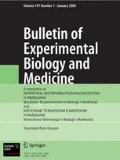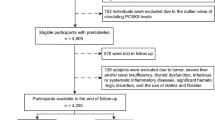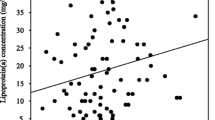The presence of a complex of lipoprotein(a) and proprotein convertase subtilisin/kexin type 9 (PCSK9) in the blood of healthy volunteers and patients with cardiovascular diseases was analyzed by ELISA. The levels of the complex varied in a wide range and did not depend on the concentrations of Lp(a) and PCSK9. Moreover, the complex was found not only in patients with cardiovascular diseases, but also in healthy volunteers, which can indicate physiological role of lipoprotein(a) as PCSK9 transporter.
Similar content being viewed by others
References
Afanasieva OI, Ezhov MV, Pokrovsky SN. Antisense oligo-nucleotides and therapeutical monoclonal antibodies as a basement for novel biological lipidlowering drugs. Ross. Kardiol. Zh. 2018;23(8):99-109. Russian.
Afanasieva OI, Razova OA, Utkina EA, Afanasieva MI, Klesareva EA, Popova AB, Ezov MV, Pokrovsky SN. The relationship between the PCSK9 and lipoprotein(a) concentrations in patients with severe hypercholesterolemia depending on the apolipoprotein(a) phenotype. Kardiol. Vestn. 2018;13(1):45-50. Russian.
Tmoyan NA, Ezhov MV, Afanasieva OI, Klesareva EA, Razova OA, Kukharchuk VV, Pokrovsky SN. The association of lipoprotein(a) and apolipoprotein(a) phenotypes with peripheral artery disease. Ter. Arkh. 2018;90(9):31-36. Russian.
Afanasieva OI, Ezhov MV, Razova OA, Afanasieva MI, Utkina EA, Pokrovsky SN. Apolipoprotein(a) phenotype determines the correlations of lipoprotein(a) and proprotein convertase subtilisin/kexin type 9 levels in patients with potential familial hypercholesterolemia. Atherosclerosis. 2018;277:477-482. doi: https://doi.org/10.1016/j.atherosclerosis.2018.08.011
Cao YX, Liu HH, Sun D, Jin JL, Xu RX, Guo YL, Wu NQ, Zhu CG, Li S, Zhang Y, Sun J, Li JJ. The different relations of PCSK9 and Lp(a) to the presence and severity of atherosclerotic lesions in patients with familial hypercholesterolemia. Atherosclerosis. 2018;277:7-14. doi: https://doi.org/10.1016/j.atherosclerosis.2018.07.030
Croyal M, Tran TT, Blanchard RH, Le Bail JC, Villard EF, Poirier B, Aguesse A, Billon-Crossouard S, Ramin-Mangata S, Blanchard V, Nativel B, Chemello K, Khantalin I, Thedrez A, Janiak P, Krempf M, Boixel C, Lambert G, Guillot E. PCSK9 inhibition with alirocumab reduces lipoprotein(a) levels in nonhuman primates by lowering apolipoprotein(a) production rate. Clin. Sci (Lond). 2018;132(10):1075-1083. doi: https://doi.org/10.1042/CS20180040
Cui Q, Ju X, Yang T, Zhang M, Tang W, Chen Q, Hu Y, Haas JV, Troutt JS, Pickard RT, Darling R, Konrad RJ, Zhou H, Cao G. Serum PCSK9 is associated with multiple metabolic factors in a large Han Chinese population. Atherosclerosis. 2010;213(2):632-636. doi: https://doi.org/10.1016/j.atherosclerosis.2010.09.027
Fan D, Yancey PG, Qiu S, Ding L, Weeber EJ, Linton MF, Fazio S. Self-association of human PCSK9 correlates with its LDLR-degrading activity. Biochemistry. 2008;47(6):1631-1639. doi: https://doi.org/10.1021/bi7016359
Kostner KM, Kostner GM. Lipoprotein (a): a historical appraisal. J. Lipid Res. 2017;58(1):1-14. doi: https://doi.org/10.1194/jlr.R071571
Luo Y, Warren L, Xia D, Jensen H, Sand T, Petras S, Qin W, Miller KS, Hawkins J. Function and distribution of circulating human PCSK9 expressed extrahepatically in transgenic mice. J. Lipid Res. 2009;50(8):1581-1588. doi: https://doi.org/10.1194/jlr.M800542-JLR200
Raal FJ, Giugliano RP, Sabatine MS, Koren MJ, Blom D, Seidah NG, Honarpour N, Lira A, Xue A, Chiruvolu P, Jackson S, Di M, Peach M, Somaratne R, Wasserman SM, Scott R, Stein EA. PCSK9 inhibition-mediated reduction in Lp(a) with evolocumab: an analysis of 10 clinical trials and the LDL receptor’s role. J. Lipid Res. 2016;57(6):1086-1096. doi: https://doi.org/10.1194/jlr.P065334
Romagnuolo R, Scipione CA, Marcovina SM, Gemin M, Seidah NG, Boffa MB, Koschinsky ML. Roles of the low density lipoprotein receptor and related receptors in inhibition of lipoprotein(a) internalization by proprotein convertase subtilisin/kexin type 9. PLoS One. 2017;12(7):e0180869. doi: https://doi.org/10.1371/journal.pone.0180869
Shapiro MD, Tavori H, Fazio S. PCSK9: From Basic Science Discoveries to Clinical Trials. Circ. Res. 2018;122(10):1420-1438. doi: https://doi.org/10.1161/CIRCRESAHA.118.311227
Tavori H, Christian D, Minnier J, Plubell D, Shapiro MD, Yeang C, Giunzioni I, Croyal M, Duell PB, Lambert G, Tsimikas S, Fazio S. PCSK9 Association With Lipoprotein(a). Circ. Res. 2016;119(1):29-35. doi: https://doi.org/10.1161/CIRCRESAHA.116.308811
Villard EF, Thedrez A, Blankenstein J, Croyal M, Tran TT, Poirier B, Le Bail JC, Illiano S, Nobécourt E, Krempf M, Blom DJ, Marais AD, Janiak P, Muslin AJ, Guillot E, Lambert G. PCSK9 Modulates the Secretion But Not the Cellular Uptake of Lipoprotein(a) Ex Vivo: An Effect Blunted by Alirocumab. JACC Basic Transl. Sci. 2016;1(6):419-427. doi: https://doi.org/10.1016/j.jacbts.2016.06.006
Author information
Authors and Affiliations
Corresponding author
Additional information
Translated from Byulleten’ Eksperimental’noi Biologii i Meditsiny, Vol. 169, No. 5, pp. 568-572, May, 2020
Rights and permissions
About this article
Cite this article
Razova, O.A., Afanas’eva, O.I., Egiazaryan, M.G. et al. Circulating Complex of Lipoprotein(a) and Proprotein Convertase Subtilisin/Kexin Type 9 in the Serum Measured by ELISA. Bull Exp Biol Med 169, 639–643 (2020). https://doi.org/10.1007/s10517-020-04944-0
Received:
Published:
Issue Date:
DOI: https://doi.org/10.1007/s10517-020-04944-0




